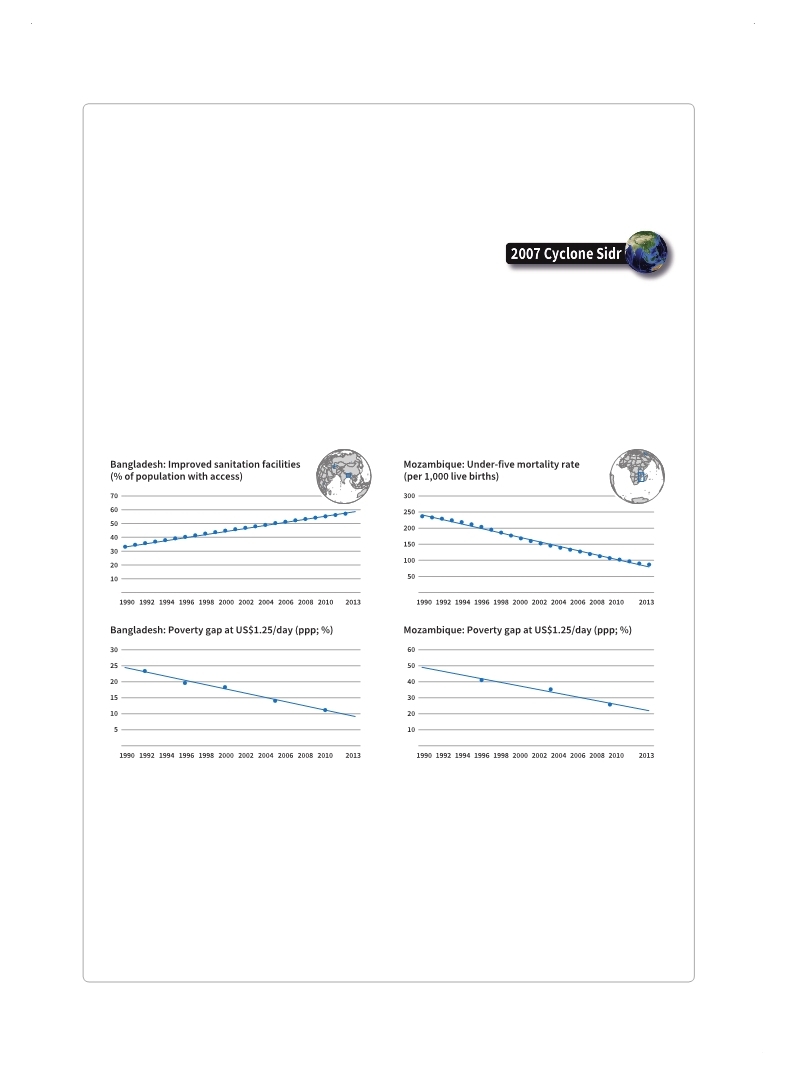 |
Global Assessment Report on Disaster Risk Reduction 2015
Making development sustainable: The future of disaster risk management |
 |
Global Assessment Report on Disaster Risk Reduction 2015
Making development sustainable: The future of disaster risk management |
|
|

46
Part I - Chapter 2
Box 2.1 Lives saved
In general, countries that have managed to reduce disaster mortality significantly have also managed to enhance disaster management within a broader context of improving development indicators. In Bangladesh, for example, an innovative cyclone shelter programme has helped the country dramatically reduce tropical cyclone mortality since the 1970s. In the past five decades, Bangladesh has been struck by three severe tropical cyclones: Bhola (1970), Gorky (1991) and Sidr (2007).
Bhola caused an estimated 300,000 deaths; Gorky was responsible for more than 138,866. The death toll for Sidr, however, was only 4,234. At the same time, Bangladesh’s major success in reducing mortality from tropical cyclones is supported not only by cyclone shelters but also by a slow but steady improvement in the provision of basic education, health and sanitation, and by a reduction in the number of people living below the poverty line (Figure 2.2).
In February and March 2000, Mozambique saw heavy flooding that affected more than 4.5 million people and killed at least 800. While the floods in January 2013 were not as severe as in 2000, the numbers of people killed and affected were reduced by around 90 per cent. A steady reduction in extreme poverty in Mozambique has gone hand in hand with a dramatic decline in the under-five mortality rate, which is a key indicator of Goal 4 of the MDGs (Figure 2.3). The country has also succeeded in reducing disaster mortality significantly over the last 20 years.
Similarly, hurricanes in Cuba in 1926 and 1932 caused approximately 600 and 2,500 deaths, respectively. In contrast, Hurricane Dennis in 2005 killed only 16 people, and Hurricane Sandy in 2012 claimed only 11 lives. Figure 2.2 Progress in selected human development indicators in Bangladesh
Figure 2.3 Decreasing poverty and under-five mortality in Mozambique
(Source: UNISDR with data from the World Bank.)
(Source: UNISDR with data from the World Bank.)
|
 
Page 1Page 10Page 20Page 30Page 36Page 37Page 38Page 39Page 40Page 41Page 42Page 43Page 44Page 45Page 46Page 47->Page 48Page 49Page 50Page 51Page 52Page 53Page 54Page 55Page 56Page 57Page 58Page 59Page 60Page 70Page 80Page 90Page 100Page 110Page 120Page 130Page 140Page 150Page 160Page 170Page 180Page 190Page 200Page 210Page 220Page 230Page 240Page 250Page 260Page 270Page 280Page 290Page 300Page 310
|
|
 
|
 
|
